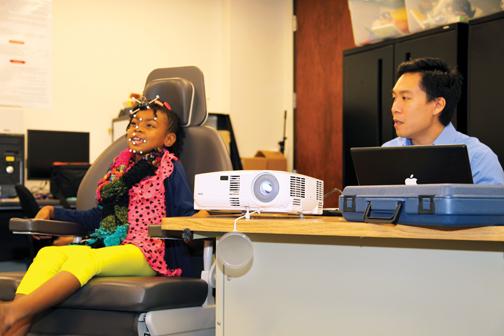 Many students walk by the San Diego State School of Speech, Language and Hearing Sciences building every day, but few realize the kind of ground-breaking research that occurs in the seemingly ordinary building.
Many students walk by the San Diego State School of Speech, Language and Hearing Sciences building every day, but few realize the kind of ground-breaking research that occurs in the seemingly ordinary building.
Speech language assistant professor Ignatius Nip and his team of SDSU students have been studying the relationship between facial movements and speech-language development in children with cerebral palsy, a motor disorder that can affect the entire body and inhibit speaking ability.
The technology captures the same motion of facial expressions as the one actors’ use to create computer-generated film characters.
“The company we bought this from has actually won Academy Awards,” Nip said. “It’s the same system they use to animate Gollum from ‘Lord of the Rings.’”
In the research lab there is a set-up similar to one you would see on a movie set. Eight optical motions-capture cameras designed to detect infrared light focus on the participant, who then have about 15 markers on their faces that reflect the infrared light, which sends a 3-D image of the participant’s face back to the computer.
“No one has looked at the speech movements of children with cerebral palsy using this type of technology,” Nip said. “We can use the information gathered to help speech-language pathologists understand how to help their clients communicate more effectively.”
For the study, Nip will examine the differences between kids from about one to 18 years of age with cerebral palsy, those developing cerebral palsy and those who don’t have it.
The children are asked to read and repeat words and phrases displayed on a projection. This allows Nip and his research team to collect and analyze how much movement is happening, how fast it’s occurring the pattern of the movement.
In a small group of the kids already studied, Nip found that all of the participants consistently moved their mouths more quickly than their average developing peers. Nip believes this is because they are not able to control their movements as precisely, so when they move their mouths to talk, they take more movement than they need to, which causes them to take more time to form words.
Findings such as these give Nip and his team fuel for a possible new form of speech therapy and intervention for kids with developing cerebral palsy.
The research is also a valuable learning opportunity for students working with Nip, which he said is one of his favorite aspects of the study. They are able to work as clinical lab participants, collecting data, working with the participants one-on-one and analyzing results. Nip said working in the lab provides the students with valuable skills they’ll be able to utilize later in a clinical setting.
The research is made possible through a three-year grant worth nearly $450,000 from the National Institute on Deafness and Other Communication Disorders. Nip hopes this research will lead to more questions and another possible grant in order to carry out the study to a therapeutic stage.







